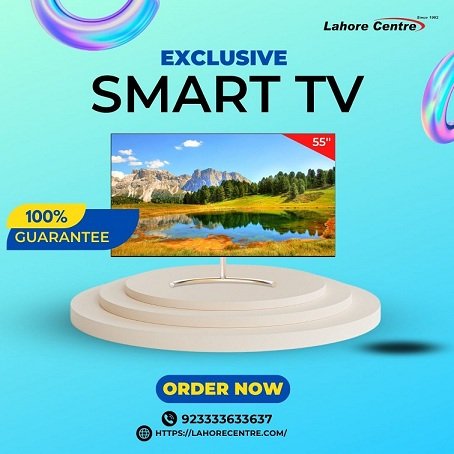Compare Android Smart LED TVs with regular Smart TVs in Pakistan. Discover UHD 4K options from TCL & Samsung at Lahore Centre with top features.
Android Smart LED TVs Vs Regular Smart TVs?
The television market in Pakistan has evolved tremendously over the past few years. The rise of Smart LED TVs has transformed how we consume content, shifting focus from traditional cable channels to on-demand streaming, gaming, and internet browsing. Among the many choices available today, two types of smart televisions dominate the market: Android Smart LED TVs and regular Smart TVs. But which one is truly better?
This blog post will dive deep into the key differences, advantages, and user experiences of both categories. We’ll also spotlight some of the top UHD 4K LED TV options, such as TCL’s latest offerings and Samsung’s Crystal series, available at Lahore Centre.
What Is a Smart LED TV?
A Smart LED TV is essentially a television that connects to the internet and supports various applications like YouTube, Netflix, Prime Video, and more. These TVs allow users to browse the web, stream videos, and even use social media platforms directly on their screen. Smart TVs come with built-in operating systems, but not all of them run on Android. This is where the distinction lies.
Understanding Android Smart LED TVs
Android Smart LED TVs run on Google’s Android TV operating system. This platform offers a more expansive ecosystem with access to Google Play Store, allowing users to download a wide range of apps, games, and streaming services. The interface is clean, user-friendly, and constantly updated with new features.
One of the best examples of an Android Smart TV is the TCL P6K UHD Android TV. This model combines stunning 4K resolution with Android’s smart capabilities, offering a seamless viewing experience with built-in Chromecast, Google Assistant, and access to thousands of apps.
Regular Smart TVs – How Are They Different?
Regular Smart TVs also offer smart features like streaming and browsing, but they use proprietary operating systems like Samsung’s Tizen, LG’s WebOS, or custom platforms. These systems are often limited in terms of app availability compared to Android, though they are optimized for performance on their respective hardware.
For instance, Samsung’s latest models like the Samsung Crystal UHD 4K DU7000 provide a fantastic visual experience with their in-house Tizen OS. While the app library may not be as vast as Android’s, it includes all the essential services and delivers a stable, secure user interface.
Android TV vs Regular Smart TV: Head-to-Head Comparison
| Feature | Android Smart LED TV | Regular Smart TV |
|---|---|---|
| Operating System | Android TV (Google) | Proprietary (Tizen, WebOS, etc.) |
| App Availability | Google Play Store – Huge variety | Limited to selected apps |
| Voice Control | Google Assistant | Varies (Bixby, Alexa, or none) |
| Casting | Built-in Chromecast | Varies (some have screen mirroring only) |
| Updates & Flexibility | Frequent updates and customization | Less frequent updates |
| User Interface | Intuitive and customizable | Manufacturer-specific, optimized UI |
| Gaming Support | High (supports Google Stadia, game downloads) | Limited |
Picture Quality: UHD 4K Makes the Difference
Regardless of the operating system, resolution plays a key role in the TV viewing experience. Models offering UHD 4K resolution deliver superior sharpness, color vibrancy, and detail. An excellent pick in this category is the TCL P71B 4K UHD Google TV. It not only supports 4K but also enhances the user experience with Google TV integration, providing content suggestions based on your viewing habits.
If you prefer Samsung’s offerings, the Samsung UHD 4K CU8000 is a strong contender. This TV brings together premium visuals and smart features on the reliable Tizen OS platform, suitable for users who don’t need extensive app customizations.
Content Accessibility and App Support
This is where Android Smart LED TVs truly shine. Since they come preloaded with Google services and access to Google Play Store, you can download apps like:
-
Netflix
-
Amazon Prime
-
Disney+
-
Spotify
-
VLC Media Player
-
Kodi
-
Plex
-
Zoom
-
And many more
Regular Smart TVs offer the basic set of apps but often lack niche or third-party apps. Some users might find this limiting if they want more customization or use lesser-known platforms.
Ease of Use and Interface
The interface of Android TVs is simple, intuitive, and highly interactive. It’s designed to resemble the smartphone interface most users are familiar with. Switching between apps, voice searching with Google Assistant, and casting from your phone are all effortless tasks.
In contrast, regular Smart TVs also offer smooth interfaces, but they are less customizable. You may not be able to install third-party apps, which might feel restrictive for tech-savvy users.
Voice Assistants and Smart Home Integration
Android TVs come equipped with Google Assistant, which allows you to control the TV, search for content, or manage smart home devices using voice commands. Integration with smart bulbs, thermostats, and other IoT devices is seamless.
Regular Smart TVs may support Bixby, Alexa, or even Google Assistant, but compatibility can vary depending on the brand and model. For example, Samsung’s Crystal UHD 4K DU7000 supports multiple voice assistants, making it a versatile choice.
Performance and Speed
Most newer Smart TVs, whether Android or not, offer fast processors and sufficient RAM. However, Android TVs tend to handle multitasking and app switching slightly better, especially in models like the TCL P6K UHD Android TV, which is optimized for performance.
Samsung’s proprietary OS is no slouch either, especially in high-end models. The Samsung UHD 4K CU8000 delivers fluid navigation with zero lag, ensuring a smooth user experience.
Price and Value for Money
When it comes to affordability, Android Smart LED TVs generally offer better value for money due to their flexibility, customization, and extensive app library. TCL has been a leading brand in offering feature-rich TVs at competitive prices. The TCL P71B 4K UHD Google TV, for instance, offers stunning visuals and the full suite of Android TV features at a budget-friendly price.
Samsung, on the other hand, tends to be slightly pricier but compensates with premium design, display quality, and brand reliability.
Where to Buy the Best Smart TVs in Pakistan?
For the latest UHD 4K LED TV models and trusted Android Smart TVs, Lahore Centre is your go-to destination. Whether you’re looking for Android TV flexibility or the performance of regular Smart TVs, their extensive inventory has something for everyone. Plus, Lahore Centre offers easy installment plans and genuine product warranties, making it easier to upgrade your home entertainment system.
Conclusion: Which TV Should You Choose?
If you’re someone who values freedom of choice, app variety, and smart home integration, an Android Smart LED TV is a better option. It offers a smartphone-like experience, advanced voice control, and compatibility with a wide array of apps and services.
However, if your needs are straightforward—watching Netflix, YouTube, and enjoying crystal-clear visuals—a regular Smart TV like those from Samsung will serve you just as well, especially models like the Samsung Crystal UHD 4K DU7000.
In the end, both categories have their merits. Your decision should depend on your tech-savviness, usage patterns, and brand preferences. Whichever you choose, make sure to shop from trusted sources like Lahore Centre to enjoy warranty-backed, high-quality products at the best prices in Pakistan.





